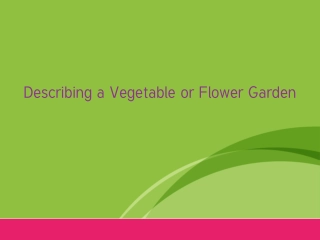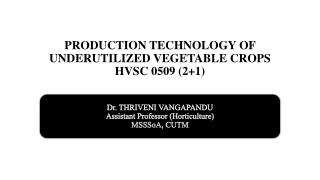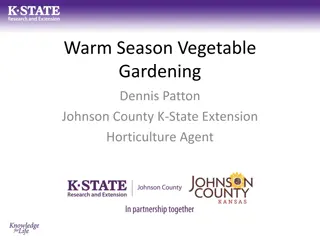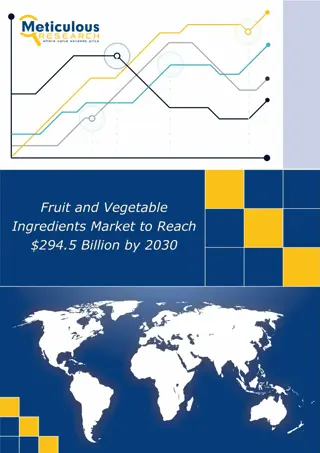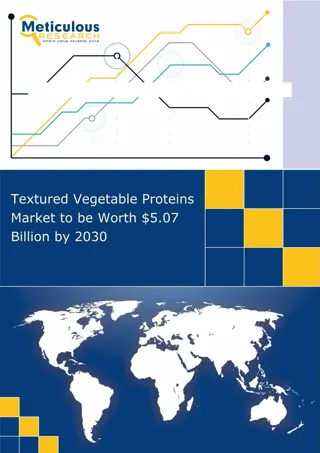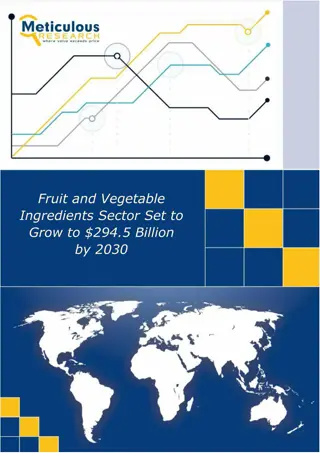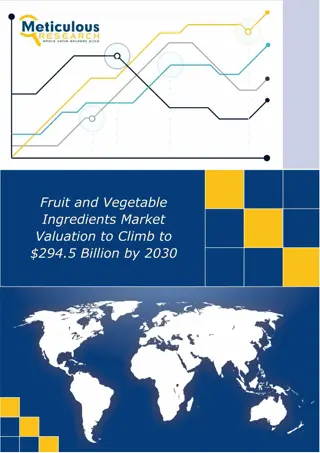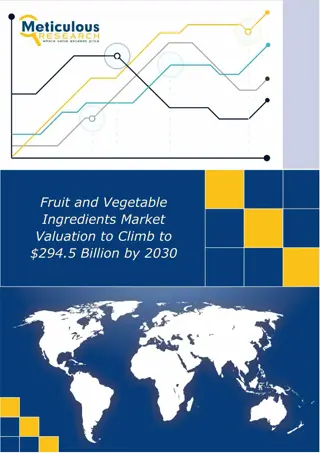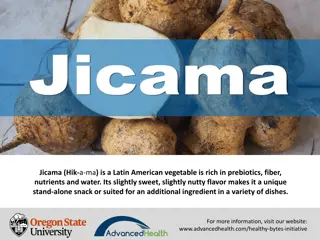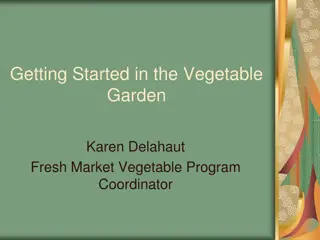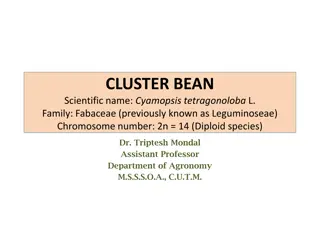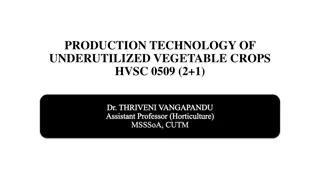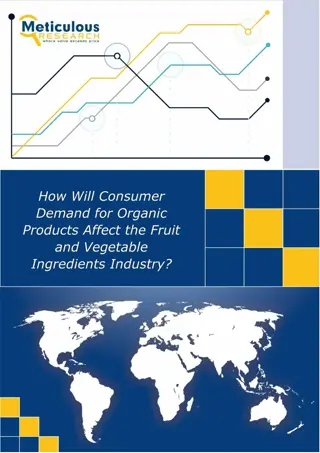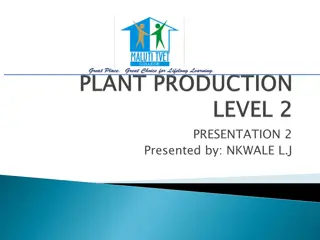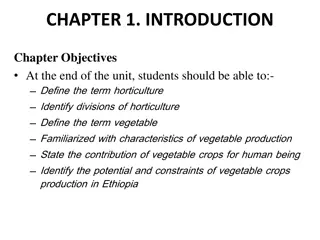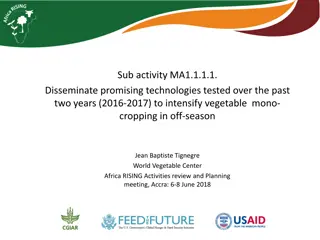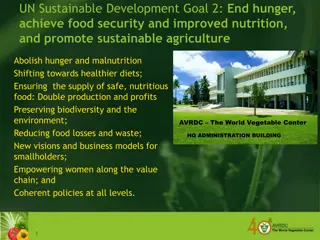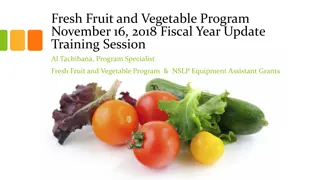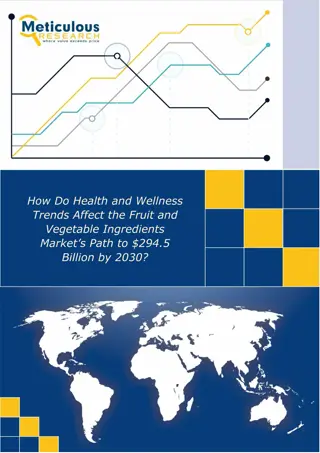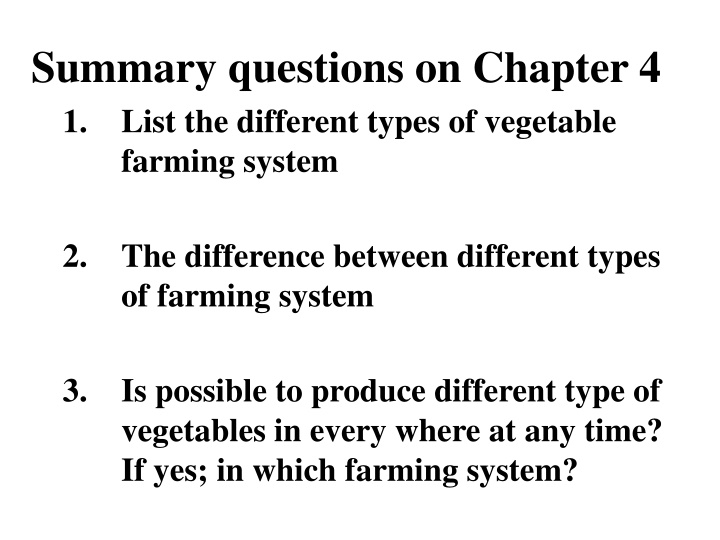
Vegetable Farming Systems and Nursery Operations
Learn about different types of vegetable farming systems, the differences between them, and whether it's possible to produce various vegetables everywhere at any time. Explore the principles of pre-planting operations in a nursery for successful vegetable crop production.
Download Presentation

Please find below an Image/Link to download the presentation.
The content on the website is provided AS IS for your information and personal use only. It may not be sold, licensed, or shared on other websites without obtaining consent from the author. If you encounter any issues during the download, it is possible that the publisher has removed the file from their server.
You are allowed to download the files provided on this website for personal or commercial use, subject to the condition that they are used lawfully. All files are the property of their respective owners.
The content on the website is provided AS IS for your information and personal use only. It may not be sold, licensed, or shared on other websites without obtaining consent from the author.
E N D
Presentation Transcript
Summary questions on Chapter 4 1. List the different types of vegetable farming system 2. The difference between different types of farming system 3. Is possible to produce different type of vegetables in every where at any time? If yes; in which farming system?
Chapter-5. Principles of Vegetable Crops Production & Management Chapter Objective At the end of the unit, you should be able to: Understand pre planting operation in nursery and post planting cares in main field
5.1. Pre-planting operations 5.1.1 Nursery Site Selection, Establishment & Management 5.1.1.1. Definition & the Need for Nursery Site The first step in successful vegetable production is Raise healthy vigorous seedlings in nursery. Young plants whether propagated from seed or vegetatively require a lot of care particularly during early stages of growth.
They have to be protected from:- Adverse temperatures, heavy rains, drought, wind & a variety of pests and diseases etc.... If small seeded vegetables are sown directly in the field, Germination is often poor & The young plants grow very slowly and Require a long time to mature. The season may be too short for full development in the field.
To overcome these problems many vegetable are grown in nursery before being transplanted in the field. But some vegetables do not transplant well; particularly Root crops & must be sown directly in the field for optimum results. It has to be noted, however that transplanting seedlings interrupts their growth which has the potential to reduce their vigor.
Therefore; nursery can be defined as: It is a compact place where seedlings are raised with maximum possible care through protection from Unfavorable condition or by providing optimum conditions for germination & subsequent growth until they are strong enough to be planted out in their permanent place during the early stages of growth. A nursery can be as simple as a raised bed in an open field or sophisticated as a glass-house with micro- sprinklers & automatic temperature control system.
Some of the benefits of raising seedling in nursery: To give the seeds better conditions for germination by growing either in seedbed or in containers, greenhouse etc.. To give intensive care for seedlings- at an early stage of development most vegetable crops require special attention that is not possible in the main field. It is used to apply optimum growing conditions to the various plants during their very early stages eg by providing good soil, protection from frost & rain by shade, diseases, insect pests & animals, weeds
It give opportunity for selection- Select well grown, vigorous, uniform & disease free seedlings for transplanting in order to obtain an even stand on the field. Thus week & disease seedlings are eliminates/discarded Extend a short growing season for late maturing crops: Seedlings can be raised in a nursery under a protected environment before conditions outside become suitable for growth & transplanted into the field when conditions allow, thus reducing the amount of time spent in the field.
To produce seedlings for transplanting to rain-fed fields at the start of the rains in adequate quantity & quality. Reduction of costs- to economize seed especially expensive hybrid seeds due to seeds are needed for direct sowing in the field require much higher than seeds require in nursery. It also saves/reduce space, water, labor, pesticides under nursery conditions than planting directly in the field
Forced vegetable production for an early market: Vegetables can be grown out-of-season in a nursery when conditions are not yet favorable. Such crops will thus mature earlier after transplanting & hence stand to fetch a higher price in the market especially when supply is low. Protection against Temperature extremes To obtain large number of plant from small area Etc .
5.1.1.2. Factors Considered During Nursery Site Selection The production of good seedlings in the nursery is largely dependent upon Suitability of nursery site chosen.
The following points should be emphasized during site selection: Proximity to planting site/main field: it is used to reduce cost of transporting & risk of loss of seedlings during transportation to the field & there by seedling failure after transplanting. Labor availability: Nursery operations are labor intensive. So; nurseries are sited in areas where regular supply of labor can be easily obtained. Market availability: it should be located as close as possible to the sites of potential buyers /grower.
Supplies condition: it should be located close to sources of inputs (equipment's or tools, seeds, pesticides, fertilizers). Availability of infrastructure- good roads (for transportation of supplies, seedlings), electricity, telecommunication etc... Climatic condition of the area- ToC (free of frost), light, wind and Rain fall condition Water supply/ availability: A nursery should be located near continuous reliable/abundant & inexpensive supply of uncontaminated water (pond, stream, river, etc).
Land which was not previously planted under the same crop- to avoid buildup of diseases & nematodes (rotation can be use as a solution) Social factors: do not displace the community etc Topography of the land: It better to have a level or gently slope land with good drainage to reduce cost of establishing the nursery considerably. If established in steeper slopes of a land; soil conservation measures (terraces) are required.
Nursery soils condition: it needs favorable soil conditions (well drained, absence of toxicity, fertile, soil pH etc.). When nursery plants are raised in pots/poly bags/trays; it may not be necessary for soils on the nursery site to be fertile. But in this case, a source of high quality soil must be as close to a nursery site as possible in order to lower the cost of soil transportation. Avoid stony or very heavy soils, which crack deeply up on drying & very sandy soils. Nursery site should be outside the range of roots & shades of trees, hedges & building, free from noxious weeds. Etc..................?
5.1.1.2. Types of nursery/growing structures (Greenhouse, lath house, cold frames & hot beds & field) Plant growing structures Are structures that are built to provide the best growing conditions for plants.
With plant growing structures we can change /manage the Growing environment such as TOC, Moisture in the atmosphere (humidity). Amount of light & For eg. photoperiod/length of the day can be modified according to the specific need of plants using black cloth to cover the structure or by the use additional light
It also used to protect young plants during the early stages of growth until they are big enough to be planted at their permanent sites from animals, insects etc... Several vegetables are raised under glass protection from the heat of the sun & provision of a humid atmosphere around house. There are a variety of plant growing structures which can be used, however, it may be used depends on The growing region & The purpose for which the structure is needed for
The commonly used plants growing structures are: Greenhouse, Hotbeds, Cold farms & Lath house
Seedling may be grown in the open field of raised bed (in open air cultivation) Problems for open air cultivation are: Damage of plants by heavy RF, flooding, Erosion, leaching, high solar radiation & evapo-transpiration & shortage of water in dry seasons, plant diseases due to rain, high humidity & storm damage & High weed infestation low ToC in some regions & Increasing use of pesticides which are washed off by rain
Advantages of protected cultivation in greenhouses are: Protection from Heavy RF, Too high radiation, Wind, insect, animal & Lower transpiration/evaporation & Better efficiency of pesticides & fertilizer & For planned production for production deadlines
To create a barrier b/n the seedlings & external environment Protect plants from wind, rain, hail, birds and insects The workers can do much better job as the facilities for work are much better. So watering & care of plant is much easier. Allows to vegetable seedlings in regions at times when outdoor condition is not be optimum. Etc
A. Greenhouse It Is a transparent roofed glass/plastic structure Used for growing plants. It provides best facilities for growing young plants by Controlling/modify many environmental conditions. Advantages of growing vegetable seedlings in greenhouse: To control & modify microclimate thus affect seed germination, root initiation, and over all plant growth
B. Hot beds (frames) The hotbed is a small/low structure which are artificially an enclosed transparent cover frame with heated beds/soil used for germinating seeds & rooting of cuttings The hotbed is a large wooden box or any other durable frame with a slopping, tight-fitting lid made of window sash or, preferably regular hotbed sash. Mainly used in cool temperature regions &/or seasons. Heat is provided below the growing medium by Electric heating cables, hot water/steam pipes, hot air flues (by burning wood or coal), or fermenting manure.
Electric system is best one due to Easily manipulated & Readily moved, Always ready for use, May be converted into cold frames by turning off the electricity The hotbed is field 10 to 15cm of the growing medium over the heating cable or any other source. Therefore, seedlings can be grown in such structures.
Cold frames (Sun frame) A plant growing structure that are covered with poly, lath or other covering material & not heated in the cold season. Primarily used for growing, protecting & hardening of young plants. These structures; helpful in tropical & subtropical regions for acclimatizing introduced plants from temperate areas The only supply of heat incase of cold frame is radiant energy. Sun enters the box during the day heating the soil and air inside. The covered frame also protects the plants from cold desiccating winds.
Lath house An outdoor less expensive shade structure, protect container grown young & tender plants from high warm season ToC & light irradiance It is also used to reduce moisture stress & water requirements of plant, for hardening off young & tender plants, to maintain shade love plants, to hold plants for sell.
It can be constructed from locally available covering materials (grass/straw) or commercially supplied covering materials (saran/poly propylene fabric or UV-treated shade cloth & from aluminum, wooden material or iron Under tropical condition instead of green house, lath house are found very necessary. Lath house provide outdoor shade and protect plants from light temperature and high light intensities.
5.1.1.3. Preparation of Media for Raising Seedlings in Nursery Soil is the major universally available medium for germinating seeds & growing seedlings. However, it is not necessarily the best medium. Some soils are unsuitable for growing seedlings. Artificial media (nursery mixes) made of perlite, sieved sand, garden soil, manure, Vermiculite & peat moss etc are used for raising seedlings.
A growth/rooting medium should have following qualities: Sufficiently firm/dense enough to hold seeds in place during germination. Capacity to supply plant nutrients; pH of the soil mix should be adjusted to a range of 6-7 to supply nutrient Have a high water holding capacity, Cation exchange capacity so that it can provide nutrients &Aeration. Organic materials, coconut coir dust, rice husk, mosses & fully decomposed dried manure are used in a nursery mix to improve soil s water holding capacity & aeration.
Free from weed seeds, nematodes and other pathogens. Nursery mix should retain only the beneficial types. To achieve this, the nursery mix is often sterilized either with the use of heat (eg. Steam sterilization, Solarization) or chemicals (gas methyl bromide, chloropicrim and vapam). The nursery soil should be fertile, loose, fine & free from disease, pests & toxic substance. Generally, it should have an OM amount from 15%-20%, Soluble N 60-100 ppm, Soluble P (P2O5) 100-150 ppm & Soluble K (K2O) 100- 200 ppm in pot soil.
D/t media are normally mixed together to obtain a near ideal mixture. Example of Proportion of nursery soil mixes are: 1: 1: 1 sieved sand: garden soil: compost 1: 1: 1 garden soil: coconut coir dust: compost 1: 1: 1 garden soil: animal manure: coconut coir dust
The widely used formula generally like this: For mother bed: Nursery soil is 6-7 portion of manure or compost and 3-4 portion of garden soil. For transplanting bed: Nursery soil is 3-4 portion of manure or compost & 6-7 portion of garden soil. If necessary, we can add some chemical fertilizers into the soil to make it more fertile. But, we should be careful with the amount of N fertilizer added.Normally, in1 cubic meter nutrient soil; for leafy vegetable seedlings 250-300 g urea & 0.5-1.0 kg superphosphate & for fruit vegetables 250-300g urea & 1-2kg super- phosphate is needed.
5.1.1.4. Pot & Bare Rooted Seedling Production Seeds can be sown directly in a seedbed of ground soil (seedling are called bare rooted seedling) at a correct spacing and depth. Advantage of growing directly on seedbed are Easy to distinguish the root pattern during transplanting Easier to arrange their root during transplanting to a field. Drawbacks- it causes high death rate after transplanting b/c of the mechanical damage occur on the root while uprooting & transporting- root exposition to the sunlight,
Seedlings can be also be grown in sufficiently large pot/poly-bags which are fill with appropriate soil mixes. The pot have holes in the bottom for drainage purpose Advantages of growing in pot Higher survival rate & faster establishment of seedlings in the field B/c of little soil disturbance while planting, Easy for seedling transportation to a distant place, Relatively less water requirement because there is little water loss etc
Disadvantage of growing in pot: Lack selection of roots Difficulty to look into the growth pattern of the root; it might be a deformed roots and It is costly (cost of polybag& too transport seedlings). 5.1.2. Seedbed Layout & CalculatingArea Seed bed is an outdoor area that are fully/partially exposed to sunlight & set aside for the production of a large number of seedlings at a minimum effort.
Establishment of nursery Requires careful planning prior to sowing seeds & it should be drawn/layout on paper that indicates:- Location & cultivar name of each vegetable, Irrigation system/channels (if applicable), drains, Nursery area, roads/paths, buildings, hedge, fence, wind breaks, Other permanent features of the nursery eg store house, office etc
Layout/planning is important To determined the number of plants needed before planting and thus to minimize land wastage For better supervision & to carry out intercultural operation in efficient manner and future explanation. Equal distribution of seedlings in the area Generally has great importance for successful /profitable vegetable seedlings growing enterprise. The above uses of careful planning/layout is become successful with proper choice of variety and care given to young seedlings
The seed bed size in the layout is calculated/determined based on the Length, width, paths, Type of vegetable grown etc Nursery area partition rate when planning/establishing nursery include the following proportion: Vegetable seedlings area is 85% or more by considering optimum spacing & Others area are for roads, building and use of other purpose
The size of nursery is depends up on; Number and type of seedlings to be raised, Production techniques eg. size of containers used & Availability of infrastructures etc Before a nursery site is prepared, the area for the nursery could be calculated taking in to account: Plant population required in the field, reserve plants needed, size of the bed & spacing for the nursery
The following steps may help in the calculation of nursery area required (Area estimation- in which seedlings are directly grown) 1. No.of seedlings per bed= 10,000cm2X Single bed dimension Intra row spacing (cm) X inter row spacing (cm) 2. No. Seedbed per ha = Total number of plants needed (plant density + allowance) No Seedling per bed 3. Net area of bed = No of beds X single bed dimension 4. Gross area= Number of seedbed X 15.12 for seedbed length of 10m (for 10x1m) or = Number of seedbed X7.56 for seedbed length of 5m (for 5x1m)
Example- Suppose we want to plant 10 ha of tomatoes at a planting density of 40,000 plants per ha with 20% allowance &if we have decided to prepare seedbed having a dimension of 10x1m with 3cm (intra row spacing) &10 cm (inter row spacing). What would be the area required for the beds and for the whole nursery? Solutions 1. No. of seedlings per bed= 10,000cm2X10 or = 3333.333 3cm X 10cm 3cm x 10cm 10 x100cm x 1x100cm (it means the size of one bed that is 10mx1m) = = 1plant ? = 3333.333
2. No. Seedbed per ha=40,000 + (40,000X20/100) beds. Therefore, for 10 ha = 140 beds are needed Or 1bed = have 3333.333 seedlings; Given 1ha= 40,000 Seedlings & allowance=40,000seedling x 20%=8000 seedlings; total number of plant required is 8000+40,000= 48000 1bed = ? beds = = 14 3333.333 3333.333 plant 48000 plant Therefore, for 10 ha = 14 bed per ha x 10= 140 beds are needed 3. Net area of beds in 10ha= 140beds X 10m2= 1800m2 Gross area of nursery = 140 beds X 15.12 (for 10x1m)= 2,116.8m2
5.1.3. Seedbed Preparation & Quality Seed Sowing A. Prior to preparing the seedbed, it is very important to decide on the position of the seedbed & the area for the nursery could be calculated (based on plant population required, reserve plants needed, size of the bed & spacing the nursery). Seed bed preparation In general, it is advisable to lay out seedbeds across the slope & according to the direction of the light to get equal chance of getting sunlight in the morning and afternoon.
Then the seedbed is prepared Seedbed preparation starts by digging (tilled) over the total area where the beds are to be established at a depth of 20cm Roots, stones and bid clods of soils should be removed or will be broken down to a fine & pressed down to avoid air spaces & then surface will be leveled & edges is firmed After digging incorporate FYM or compost (2 kg m2) & DAP (20gm m2of the bed area) if needed. If the soil has low fertility; add 10gram each of N, P2O5& K2O for 1m2 of bed area for most vegetable crops. Then mix the fertilizer well
Moreover, a border of soil about 5-7 cm high & wide around the edge of each bed will be raised to prevent water run off and consequent erosion After two or three weeks; sow the seeds in 0.5-1cm in a deep furrows and cover the seeds with soil. Then after sowing; all cultural practices required for germination & growth of seedlings are applied eg. Mulching, Watering etc
Three kinds of seedbeds are Commonly used in producing vegetable seedlings depending on the Soil and Climatic/weather conditions These are Raised, sunken and flat bed
Raised seed-beds: It is the most common type of nursery beds which have been accepted widely by vegetable growers. The soil b/n bed will be dig 5cm deep & the soil be thrown on the beds to raise the seedbed by 10-20cm higher than surrounding path. The bed have a width from 1.0 to 1.2/1.5 m & mostly length of convenient size 5-10 m & paths of 40-60cm are left b/n beds to facilitate the movement of the workers b/n the beds without stepping on the beds.
It is constructed in High RF /rainy season or When water logged soil condition is expected (poorly drained soils (clay soils)) To facility drainage. The advantages this bed is To encourages drainage & root development of seedlings & Facilitates easy removal of seedlings for transplanting without damaging their roots.

